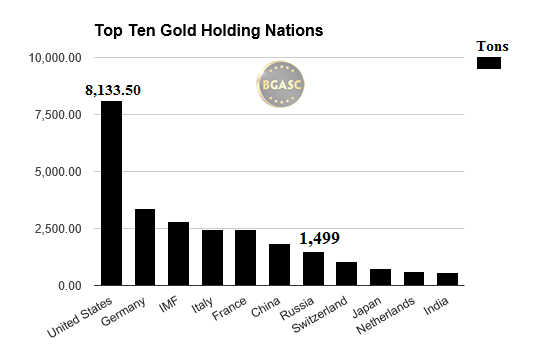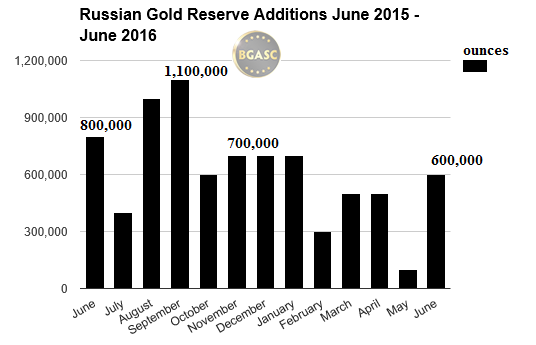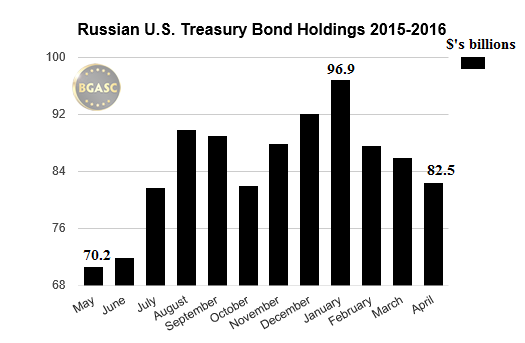
Russia Adds 19 Tons of Gold To Reserves in June
Russia Continues to Lead the World’s Central Banks in Gold Purchases
The Russian Central Bank announced this week that its gold reserves had reached 48.2 million troy ounces (approximately 1,500 metric tons). The total included an additional 600,000 ounces (approximately 19 tons) of gold added in June.
Over the past two years, Russia has led the world in adding gold to her central bank reserves, ahead of the People’s Bank of China, the central bank that has added the second largest of amount of gold.
The Central Bank of Russia added a record 208 tons of gold to reserves in 2015. Last year Russia suffered financially as international sanctions and plummeting oil prices took their toll on the rouble and the inflation rate reached double digits. According to the World Bank, oil is by far Russia’s largest export and represents about 15-20% of Russia’s GDP and the majority of government revenues. 2016 has started off better for Russia. The price of oil and gold have increased significantly in 2016 and have helped Russia improve its financial situation and reserves.
The pace of Russia’s gold purchases has remained relatively steady over the past two years. In May, Russia added ‘just’ 100,000 ounces ( approximately 3 tons) to her reserves, the lowest amount that Russia had added since May 2015. Also in May, the Chinese central bank announced that it had added no gold to its reserves. The cessation of the People’s Bank of China’s gold purchases and the relatively small amount of gold added by the Central Bank of Russia in May, caused some gold market observers to suspect that both central banks were winding down their gold purchases, perhaps in reaction to the increasing price of gold.
Earlier this month, the People’s Bank of China announced that it had added 480,000 ounces (approximately 15 tons) of gold to her reserves in June.
Russia Adds Gold To Reserves Despite Economic Weakness
Despite the weakness in the Russian economy, the Russian Central Bank has bolstered its foreign reserves from about $350 billion a year ago to over $390 billion at the end of June 2016. The Russian Central Bank has a stated goal of increasing reserves to about $500 billion in the coming years.
As of June 30 2016, gold constituted about 13% of the Central Bank of Russia’s $392 billion reserves with her gold hoard valued at approximately $51 billion.

U.S. Treasuries as Part of Russia’s Foreign Reserves
In January 2014, Russia’s U.S. Treasury position was $131 billion. In reaction to U.S. inspired sanctions being placed on her, Russia sold a substantial portion of her U.S. Treasury holdings. Russian U.S. Treasury holdings reached a low of $66.5 billion in April 2015. Since then Russia has added back a portion of its U.S. Treasury holdings. As of May 2016, Russia held $88.2 billion in U.S. Treasury Securities.

The Gold Option
Russia’s pace of adding gold to reserves is the fastest in the world, surpassing China whose gold reserve additions over the past year are the second highest. From August to June 2016 China added 145 tonnes of gold to its reserves, while Russia added 212 tonnes, or 46% more.
As a result of Russia’s gold buying binge, Russia has vaulted into the top ten gold holding nations and is now the sixth largest.

Russia’s decision to add gold to reserves has paid off as the price of gold has risen nearly 25% over the past year, with most of the gain coming in 2016. Russian gold mining produces the third largest annual output in the world. Exchanging depreciating Roubles for a good portion of their gold mining output has helped increase the value of Russia’s reserves. By retaining an increasing percentage of its gold mining output the Central Bank of Russia has been in effect converting roubles into gold.
This article by BGASC is not, and should not be regarded as, investment advice or as a recommendation regarding any particular course of action.
